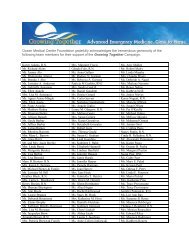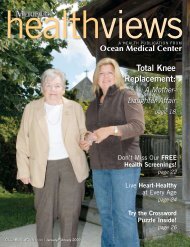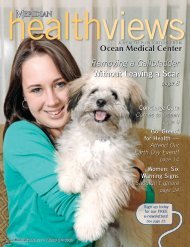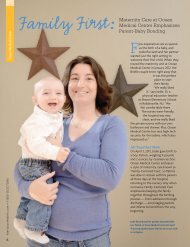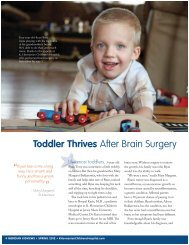Download the September/October 2013 Issue - Ocean Medical Center
Download the September/October 2013 Issue - Ocean Medical Center
Download the September/October 2013 Issue - Ocean Medical Center
Create successful ePaper yourself
Turn your PDF publications into a flip-book with our unique Google optimized e-Paper software.
Jersey Shore University <strong>Medical</strong> <strong>Center</strong><br />
MeridianHealth.com • 1-800-DOCTORS<br />
10<br />
Patient Gains a Chance at a<br />
New Life<br />
Last year, Phyllis Mills had an MRI<br />
after suffering a fracture in her back.<br />
That test very likely saved her life.<br />
Images showed that Phyllis, 57, had<br />
an abdominal aortic aneurysm, a<br />
weak and enlarged area in <strong>the</strong> lower<br />
part of <strong>the</strong> aorta — <strong>the</strong> major blood<br />
vessel that supplies blood to <strong>the</strong><br />
body. Abdominal aortic aneurysms<br />
often grow undetected because<br />
<strong>the</strong>y typically produce no symptoms.<br />
But <strong>the</strong>se aneurysms can be fatal if<br />
<strong>the</strong>y rupture.<br />
“Pressure gradually builds inside<br />
an aneurysm, expanding part of <strong>the</strong><br />
aorta like a balloon. If <strong>the</strong> aneurysm<br />
bursts, it can cause internal bleeding,”<br />
explains M. Usman Nasir Khan, M.D.,<br />
vascular surgeon at Jersey Shore<br />
University <strong>Medical</strong> <strong>Center</strong> and part of<br />
Meridian CardioVascular Network.<br />
“About 80 percent of people with<br />
a ruptured aortic aneurysm die<br />
before <strong>the</strong>y can call 911. Of those<br />
who are rushed to <strong>the</strong> Emergency<br />
Department, <strong>the</strong> majority don’t make<br />
it to surgery. The key is to repair <strong>the</strong><br />
aneurysm before it can rupture.”<br />
A Fast-Growing Aneurysm<br />
At <strong>the</strong> time of diagnosis, Phyllis’<br />
aneurysm was 4 cm. Typically, aneurysm<br />
repair is not recommended until about<br />
5 cm. Before that time, surgery is<br />
considered a greater risk than rupture.<br />
Although abdominal aneurysms<br />
are usually slow-growing, imaging<br />
tests taken just six months after her<br />
initial diagnosis showed that Phyllis’<br />
aneurysm had grown to a dangerous<br />
6.5 cm. The test also showed that she<br />
had significant heart blockage and<br />
needed triple bypass surgery.<br />
“I was shocked and scared at how<br />
quickly <strong>the</strong> aneurysm grew. But I had<br />
to focus on my heart first,” Phyllis says.<br />
“As soon as I had bypass surgery, my<br />
heart surgeon referred me to Dr. Nasir<br />
Khan for aneurysm repair.”<br />
Phyllis met with Dr. Nasir Khan,<br />
who performed a special CT scan<br />
to examine her blood vessels. He<br />
determined she was a candidate for<br />
percutaneous aneurysm repair — a<br />
unique procedure that is performed<br />
entirely through two small needle<br />
holes.<br />
Rare Percutaneous Repair<br />
Dr. Nasir Khan is one of <strong>the</strong> only<br />
surgeons in <strong>the</strong> area to offer<br />
percutaneous abdominal aortic<br />
aneurysm repair. And Phyllis was<br />
among <strong>the</strong> first in <strong>the</strong> region to<br />
undergo <strong>the</strong> cutting-edge procedure.<br />
“Traditional abdominal aortic<br />
aneurysm surgery is performed<br />
with open surgery, accessing <strong>the</strong><br />
aneurysm by making a large incision<br />
in <strong>the</strong> belly. And most minimally<br />
invasive procedures require at least<br />
one small incision near <strong>the</strong> groin,”<br />
explains Dr. Nasir Khan. “However,<br />
percutaneous aneurysm repair<br />
requires no incisions at all.”<br />
Just three weeks after Phyllis<br />
underwent triple bypass surgery,<br />
Dr. Nasir Khan repaired her aneurysm<br />
at Jersey Shore using <strong>the</strong> specialized<br />
approach.<br />
“Before <strong>the</strong> procedure, Dr. Nasir<br />
Khan sat down with me and<br />
explained everything about it. He<br />
didn’t rush. He didn’t talk above<br />
me,” recalls Phyllis. “He took his time<br />
and made me feel comfortable. I<br />
trusted him.”<br />
To repair <strong>the</strong> aneurysm, Dr. Nasir<br />
Experience Matters<br />
M. Usman Nasir Khan, M.D.<br />
Board certified in Vascular<br />
Surgery<br />
Neptune • 732-212-6598<br />
Khan worked through needles<br />
inserted in <strong>the</strong> groin, guiding<br />
special instruments through <strong>the</strong><br />
blood vessels to <strong>the</strong> area of Phyllis’<br />
aneurysm. Dr. Nasir Khan <strong>the</strong>n built<br />
a stent graft from inside <strong>the</strong> aorta — a<br />
flattened tube made from metal<br />
and wire material. He <strong>the</strong>n opened<br />
<strong>the</strong> stent graft, creating new vessel<br />
walls for <strong>the</strong> blood to flow through.<br />
This allowed <strong>the</strong> blood to bypass<br />
<strong>the</strong> weakened area of <strong>the</strong> aorta,<br />
relieving pressure in <strong>the</strong> aneurysm and<br />
reducing <strong>the</strong> risk for rupture.<br />
“Percutaneous is a fairly rare<br />
approach to abdominal aortic<br />
aneurysm repair because it takes<br />
extensive training and skill to<br />
perform,” Dr. Nasir Khan says.<br />
“However, it can benefit patients<br />
over o<strong>the</strong>r minimally invasive options<br />
because <strong>the</strong>re is less risk for pain and<br />
infection.”<br />
A New Beginning<br />
Just 24 hours after Phyllis went for<br />
her aneurysm repair she was back at<br />
home and feeling fine. And after a<br />
period of time to recover from heart<br />
surgery, she is back to her physically<br />
demanding job setting up lighting<br />
displays.<br />
“I know that my aneurysm could<br />
have burst at any moment. If it weren’t<br />
for Dr. Nasir Khan, I might not be here<br />
today,” Phyllis says. “Thanks to excellent<br />
medical care, I have a new life.”<br />
Experience is one way to measure quality. In 2012, <strong>the</strong> team<br />
at Jersey Shore University <strong>Medical</strong> <strong>Center</strong> performed <strong>the</strong> most<br />
diagnostic caths in New Jersey. They also completed <strong>the</strong><br />
second most interventional PCI procedures and <strong>the</strong> third most cardiac<br />
surgeries. Go to JerseyShoreUniversity<strong>Medical</strong><strong>Center</strong>.com to learn<br />
more about our heart and cardiovascular surgery programs.





